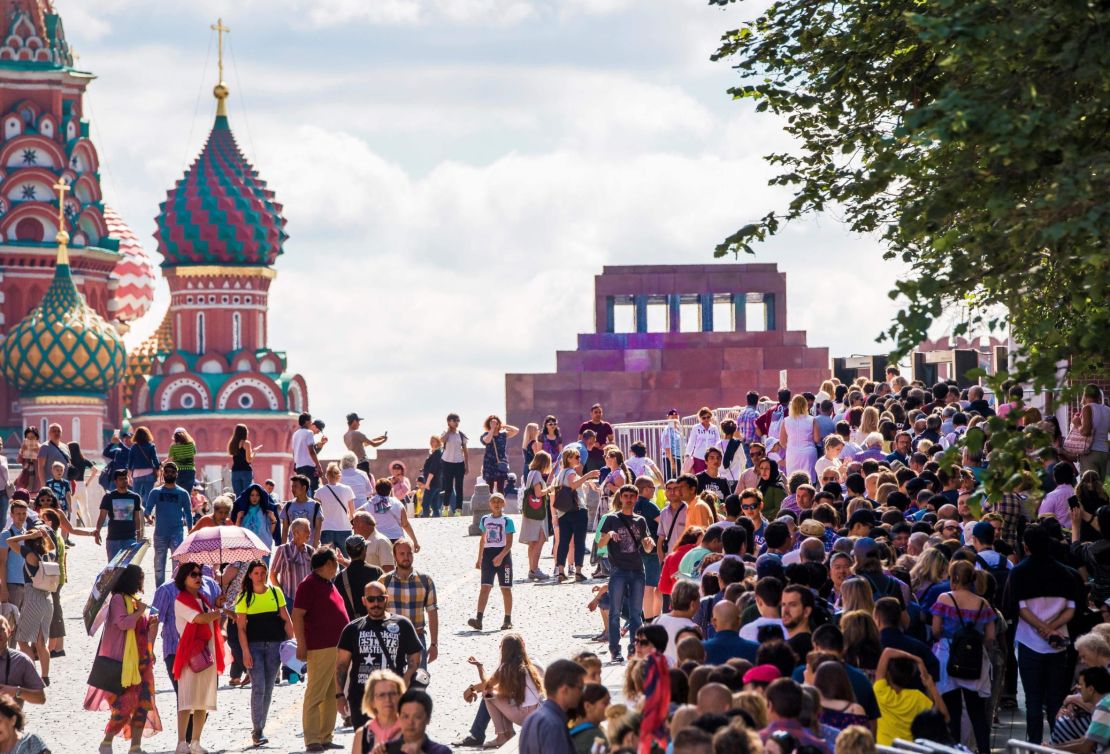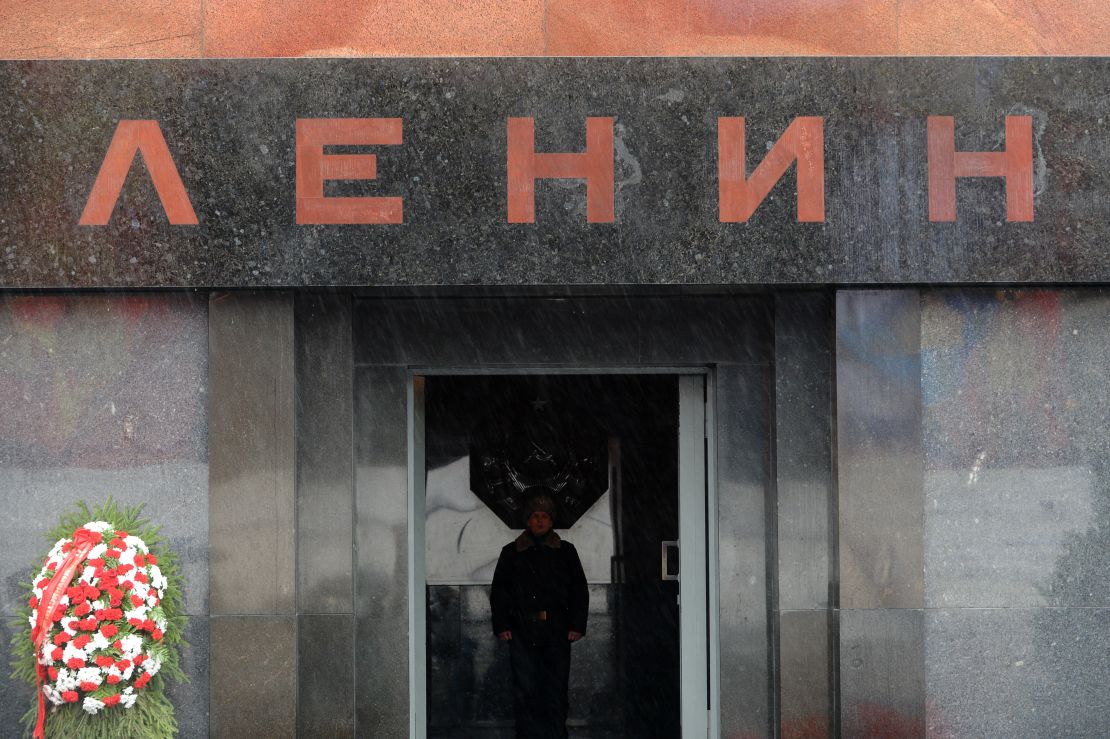Visiting the attractions of Moscow’s Red Square can be expensive, but there’s one that remains free: the embalmed body of communist leader Vladimir Lenin.
A century after Lenin led a revolution that changed the world, his preserved corpse remains a subject of curiosity and conflict in Russia, but time could be running out on this unusual Soviet-era spectacle.
Today, visiting Lenin is heavily regimented.
After navigating through metal detectors and a line that nearly stretches around one corner of the Kremlin wall, visitors walk down a flight of stairs into a tomb of dimly lit polished stone. After being told by a guard to take hands out of pockets, visitors then move right to find themselves in a cube-shaped chamber, wherein lies the man himself.
Lenin’s body appears strikingly small for a man of such historical significance (he was 5 feet 5 inches or 165 centimeters tall) and he looks more like one of Madame Tussauds’ wax figures than a well-preserved corpse.
Beneath bulletproof glass and sharply dressed in the new suit he was outfitted in this spring, his flesh is luminous against the room’s dark red and black trappings.
There’s little time to dwell on details. Guards keep guests moving in a U-shape around the elaborate casket, enforcing reverence with a strict no-talking, no-photography, no-cellphone policy until exiting the mausoleum, where the sunlight in Red Square is jarring even after only a few minutes underground.
November 2017 marks the 100th anniversary of the October Revolution (the month discrepancy is the result of a Lenin-era revision to Russia’s calendar system); and 93 years after his death and display in Red Square, the resting place of the Father of the Revolution is now a UNESCO World Heritage Site and popular tourist destination.
Communism in the flesh

Not so long ago, it likely would have been shocking to Russians that Lenin’s Mausoleum would be just another highlight on a travel to-do list, squeezed in between St. Basil’s selfies and a stroll through GUM department store.
The mausoleum once held almost religious gravity in Russian culture, with Soviets waiting in the cold for hours just to catch a glimpse and leave a flower.
Today, it’s a less somber affair, attracting the morbidly curious or history buffs who want to see communism in the flesh. Long lines are common, but they’re more likely the result of very limited opening hours than of extremely high demand.
There are Russian voices in the crowd, but they’re mingled with the chatter of a variety of other languages, laughing and just killing time waiting to get inside. Apart from the occasional earnest Lenin devotee, most solemnity is merely forced by some very serious mausoleum guards.
Attitudes toward Lenin have transformed so much, in fact, that visitors to Moscow may eventually find the door of the Lenin Mausoleum closed for good.
A poll in March 2017 found that at least 58% of Russians are in favor of finally removing Lenin from display, but there’s indecision over whether he should be buried with other communist bigwigs at the Kremlin or, as was his own wish, buried next to his mother in St. Petersburg’s Volkovo Cemetery.
Beyond his embalmed body, there’s no shortage of other glimpses of Lenin around the Russian capital, thanks to strong public support for preserving monuments in his honor.
Muzeon Park of Arts has plenty of busts and statues of the communist leader to enjoy while taking a leisurely walk to Gorky Park.
‘Persecutor and executioner’

Richard Lourie, author of “Putin: His Downfall and Russia’s Coming Crash,” attributes Lenin’s enduring presence to Russians’ need for some continuity after a tumultuous century.
“With the collapse of the USSR there was little physical violence but a lot of spiritual damage was done,” he says. “Children grew up singing a different national anthem and saluting a different flag from the ones their parents had. People’s values were turned upside down. And so keeping the mausoleum makes sense to them.”
The Russian Orthodox Church outside of Russia, however, laments “the rejection of the divinely ordained government” and seeks to “rid Red Square of the remains of the main persecutor and executioner of the 20th century.”
But on the topic of Lenin’s final resting place, some are willing to bury resentment – and Lenin along with it.
Top attractions in Russia
“As it is known that Lenin was a baptized Russian Orthodox Christian, I believe he should receive an Orthodox Christian burial,” Protopresbyter Alexander Lebedeff, rector of Holy Transfiguration Russian Orthodox Church in Los Angeles, tells CNN Travel. “Who can say that he did not perhaps repent in the last hours of his life?”
The fate of Lenin’s body has long been the focus of political debate, and lawmakers from the Liberal Democratic Party of Russia and President Vladimir Putin’s United Russia party recently proposed legislation that would have made burial a reality. Lacking support, the idea was rejected.
Putin’s own reluctance to get involved in the fate of his predecessor could help preserve the mausoleum, says Angus Roxburgh, a former PR adviser for Putin’s Kremlin and author of “Moscow Calling: Memoirs of a Foreign Correspondent.”
“He knows that most Russian people don’t really care that strongly about it, so, faced with the choice between huge protests over Lenin’s removal, and a little bit of grumbling if Lenin stays, it is easiest for Putin just to stick with the status quo.”
Putin has chosen instead to focus on indisputable national victories such as World War II – or the Great Patriotic War, as it’s known in Russia – to bring Russians together.
Russian identity

“It is unquestionably a fixture of Red Square now,” says Steven Lee Myers, a former Moscow bureau chief for The New York Times and author of “The New Tsar: The Rise and Reign of Vladimir Putin.”
“But also one that Putin’s Kremlin often covers up during important events, like the Victory Day parades each May. They drape it or cover it with scaffolding. It’s like an embarrassing relic. … The days of Soviet leaders standing on it are long gone,” Myers tells CNN Travel.
David Satter – author of four books on Russia and a former Moscow correspondent for the Financial Times – says shifting Lenin may not be worth the political headache or cultural upheaval.
“Removing Lenin’s body would upset […] the equilibrium that exists at the present time,” Satter says. “It may not be that people are particularly enthusiastic to have him there, to have his remains there, but at the same time are not anxious to get embroiled in a controversy.
“It may require a kind of rethinking about Russian identity in order for that to happen.”
The pilgrimage to see Lenin has less of the theatrics than it had when the current mausoleum opened in 1930, replacing the wooden structure that was hastily built to accommodate crowds of mourners.
The Honor Guard that goose-stepped outside has been stripped from Lenin and moved to the Tomb of the Unknown Soldier, where visitors’ attention is diverted away from the mausoleum for the hourly changing of the guard.
And the team of scientists that dote on the former revolutionary leader – and also the corpse of Vietnamese leader Ho Chi Minh on display in Hanoi – is much smaller than it once was.
Yet even the brief minute or so that visitors are allotted with Lenin leaves a lasting impression.
The experience offers a glimpse of Soviet culture and what it held sacred, and of a once integral aspect of Russian identity that may be slipping away with each new generation.






















